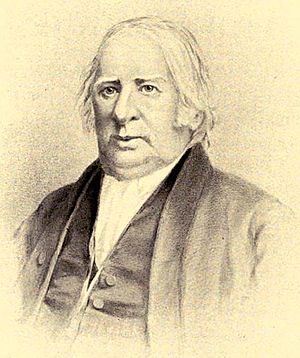Edward Pease (railway pioneer) facts for kids
Edward Pease (born May 31, 1767 – died July 31, 1858) was a very important person in the early days of railways. He was a woollen manufacturer from Darlington, England. Edward Pease was the main person who pushed for the Stockton and Darlington Railway. This railway opened in 1825 and was a huge step forward for transport. Because of his big role, he is often called the "Father of the Railways."
Contents
Who Was Edward Pease?
Edward Pease was born on May 31, 1767. He was the oldest son of Joseph Pease and Mary Richardson. His family lived in Darlington and ran a woollen manufacturing business.
The Pease family were well-known Quakers. Quakers are a religious group known for their peaceful beliefs. Edward's brother, Joseph Pease, was even involved in starting the Peace Society. He also worked to end slavery.
Edward went to school in Leeds. When he was 15, he joined his father's woollen business. In 1796, he married Rachel Whitwell, who was also a Quaker. They had five sons and three daughters.
Building the First Public Railway
Edward Pease became very interested in improving transport in 1809. He wanted to make it easier to move coal from mines in County Durham. This would help them compete with other coal suppliers. At first, people thought about making the River Tees easier to travel on. But soon, the idea of building a railway took over.
Pease brought in George Stephenson, a famous steam engine maker. At first, the plan was for a railway pulled by horses. But thanks to Pease and Stephenson, it quickly changed to a steam-powered line. Another important person was Jonathan Backhouse, a banker from Darlington and Pease's cousin.
Making Steam Power a Reality
Edward Pease was seen as a smart and careful businessman. He had to show that using steam engines would be a good investment. His young son, Joseph, helped by writing the company's plan.
In 1821, Parliament approved the railway plan. In 1823, a company called Robert Stephenson and Company was started in Newcastle upon Tyne. This company would build the steam locomotives. Edward Pease was one of the main people behind it.
George Stephenson was put in charge of building the railway. The Stockton and Darlington Railway officially opened on September 27, 1825.
How the Railway Worked at First
At the beginning, the railway company only provided the tracks. Anyone who wanted to move goods could hire the tracks. They could use horses or steam engines to pull their trains.
Over time, it became clear that a more organized system was needed. Drivers often argued about who had the right of way. Also, steam locomotives could go much faster, which made things more dangerous. So, the railway slowly moved towards a more standard way of managing trains.
Edward Pease's Later Life and Legacy
In 1829, Edward Pease stepped back from running the railway. His second son, Joseph, took over. Like his uncle, Joseph was a strong supporter of the anti-slavery movement. He also worked to improve prisons. In 1832, Joseph Pease made history by becoming the first Quaker to be a Member of Parliament.
Edward Pease had many connections with Quaker bankers. This helped a lot in getting money and support for the railway. He also invested a lot in Stephenson's new company that built locomotives. Edward retired from business in 1833. However, he remained active in his Quaker religious life.
Edward Pease stayed good friends with George Stephenson and his son Robert throughout his life. He passed away in Darlington on July 31, 1858, from heart failure. He was buried in the Quaker burial ground in Skinnergate.
Remembering a Pioneer
The writer Samuel Smiles described Pease as "a thoughtful and wise man." He said Pease was full of ideas, had great energy, and never gave up. Edward Pease's diaries were published in 1907, giving us a look into his life.
Today, there is a statue of Joseph Pease in the center of Darlington.
Locomotion No. 1 was the very first engine to carry passengers by steam on a public railway. It used to be displayed at Darlington Bank Top railway station. This was a monument to Edward Pease and the Stockton and Darlington Railway. Later, it was moved to North Road station. Now, you can see it at the National Railway Museum branch in Shildon, County Durham. This was once a main operating base for the railway.
When the foundation stone was laid for the monument in Darlington, Henry Pease gave a speech. He said he was happy to see the first locomotive being placed in a good spot. He believed it would help people remember "one of the greatest events the civilised world ever witnessed."
External sources
- Edward Pease, National Portrait Gallery, London
- Bautz, Traugott, ed. (2009). "Edward Pease (railway pioneer)" (in de). Biographisch-Bibliographisches Kirchenlexikon (BBKL). 30. Nordhausen: Bautz. cols. 1098–1100. ISBN 978-3-88309-478-6. http://www.bbkl.de/p/pease_e.shtml.
- https://web.archive.org/web/20050209121421/http://www.railcentre.co.uk/stockton/stocktonmenu.htm
- Darlington Quaker Photographs
- The Diaries of Edward Pease


